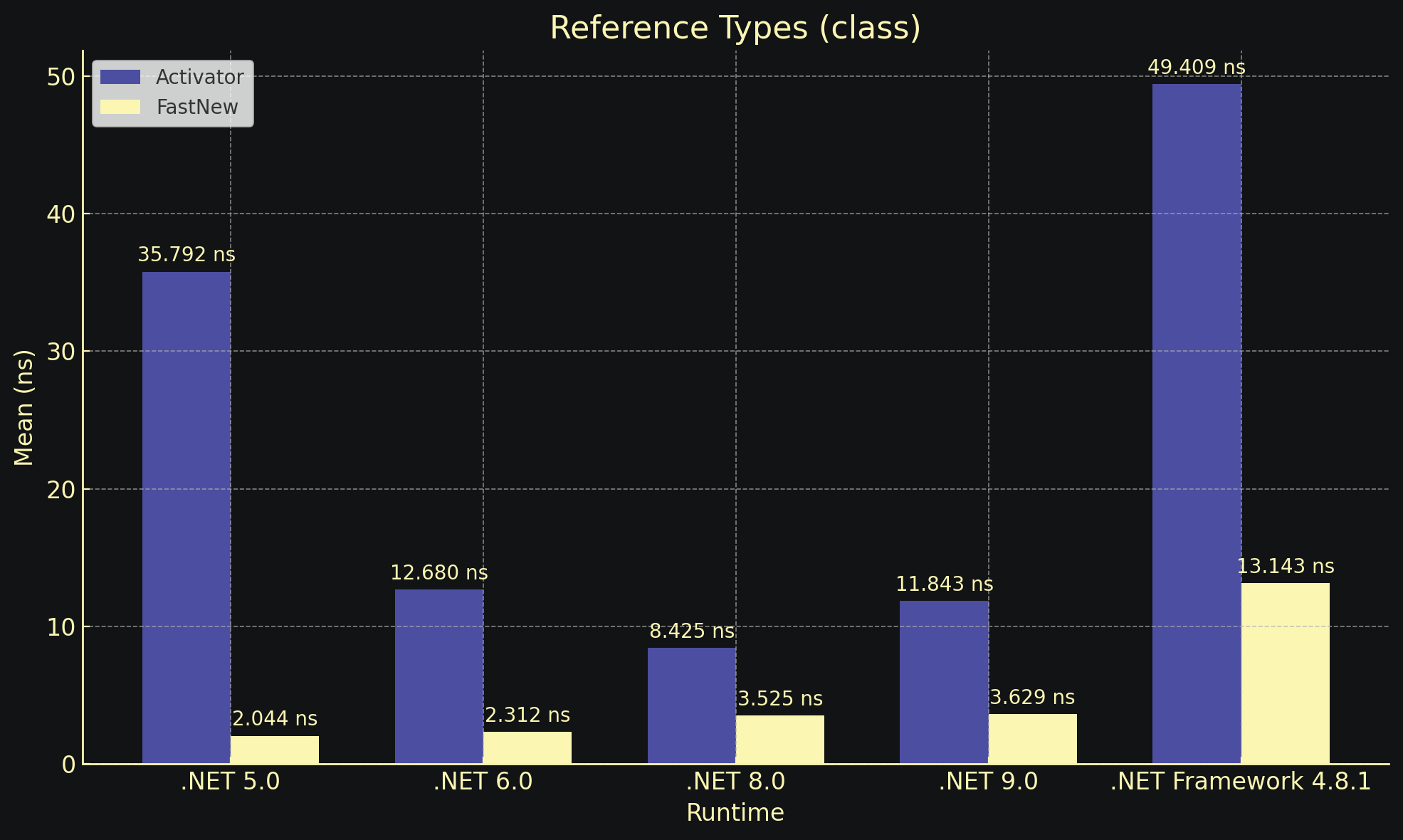-
✔️ The best
CreateInstanceever- Up to 50x faster than
Activator.CreateInstance<T> - Generic Parameters Support
- Zero boxing/unboxing
- TryGetValue-like TryFastNew API
- Link Mode
PublishTrimmedSupport - Non-Public Constructor Support
- No Generic Constraints
- Compatible with .NET Standard 2.0
- Multiple backend implementations
- Heavily tested on Win/Mac/Linux
- Up to 50x faster than
-
🪛 Modern Compiler Integration
- Source Generator v2 (Incremental Generator)
- Highly Configurable (Props)
- Multi-threaded Generation
-
🔥 Latest C#/.NET Features Support
- C# 8 Nullable Support
- C# 10 Parameterless struct constructors Support (Both invokes or not)
- WebAssembly Support
You should only use one of them
dotnet add package FastGenericNew --version 3.3.1<ItemGroup>
<PackageReference Include="FastGenericNew" Version="3.3.1" />
</ItemGroup>dotnet add package FastGenericNew.SourceGenerator --version 3.3.1<ItemGroup>
<PackageReference Include="FastGenericNew.SourceGenerator" Version="3.3.1" />
</ItemGroup>.NET Standard 2.0 or above
C# 8.0 or above
Roslyn 4.0.1 or above
Modern IDE (Optional) [VS2022, Rider, VSCode]
using FastGenericNew;
// Simply replace 'Activator' to 'FastNew'
var obj = FastNew.CreateInstance<T>();
// With parameter(s)
var obj2 = FastNew.CreateInstance<T, string>("text");
var obj3 = FastNew.CreateInstance<T, string, int>("text", 0);
// Try pattern
// NOTE: The try pattern will only check if the constructor can be called.
// It will not catch or handle any exceptions thrown in the constructor.
if (FastNew.TryCreateInstance<T, string>("arg0", out T result));
{
// ...
}With .NET Framework,
Activator.CreateInstance<T>()invokes the parameterless constructor of ValueType if
the constraint iswhere T : new()but appears to ignore the parameterless constructor if the constraint iswhere T : struct.
ButFastNew.CreateInstance<T>()will always invoke the parameterless constructor if it's available.If you don't want to invoke the parameterless constructor of ValueType, consider using
FastNew.NewOrDefault<T>()which will never invoke the parameterless constructor ofValueType
Check the full benchmark results here:
https://github.com/Nyrest/FastGenericNew/blob/main/benchmark_results.md
BenchmarkDotNet v0.14.0, Windows 11 (10.0.22631.3958/23H2/2023Update/SunValley3)
AMD Ryzen 9 3900X, 1 CPU, 24 logical and 12 physical cores
.NET SDK 9.0.100-preview.7.24407.12
[Host] : .NET 8.0.3 (8.0.324.11423), X64 RyuJIT AVX2
Job-GFVMQQ : .NET 5.0.17 (5.0.1722.21314), X64 RyuJIT AVX2
Job-FGYWFO : .NET 6.0.33 (6.0.3324.36610), X64 RyuJIT AVX2
Job-LODQQQ : .NET 8.0.3 (8.0.324.11423), X64 RyuJIT AVX2
Job-NXJWMD : .NET 9.0.0 (9.0.24.40507), X64 RyuJIT AVX2
Job-VBBRLS : .NET Framework 4.8.1 (4.8.9256.0), X64 RyuJIT VectorSize=256
FastGenericNew is licensed under the MIT license.




